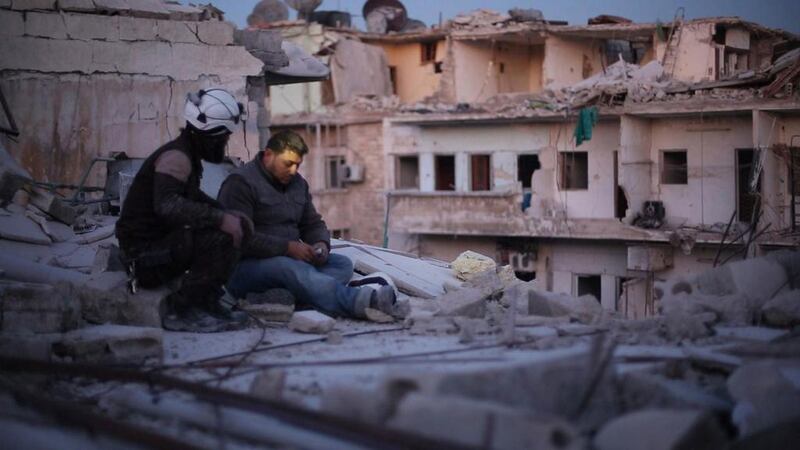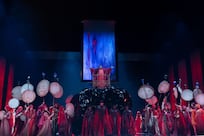The continuing conflict in Syria was high on the agenda at the Sundance Film Festival this year. Three films – Cries from Syria, City of Ghosts and Last Men in Aleppo – examined different aspects of the conflict, with one of them rewarded with one of the festival's main prizes.
With diplomatic efforts to end the almost six-year war stalling, and UN estimates of the death toll now standing at well over 400,000, plus millions displaced, all three filmmakers attempted to shed light on the human stories behind the statistics.
City of Ghosts, directed by American Matthew Heineman, and Last Men in Aleppo, helmed by Syrian filmmaker Firas Fayyad and Steen Johannessen, from Denmark, look at specific cities.
In the former, Heineman explores the work of the citizen journalists of Raqqa, who formed a collective known as “Raqqa is Being Slaughtered Silently” in their struggle to combat the propaganda machine of ISIL, who have declared the city the capital of their caliphate and are oppressing the citizens.
The focus of Last Men in Aleppo – which on Saturday night received the grand jury prize in the World Cinema documentary competition – is the work of the White Helmets. This is another group of ordinary citizens, who have organised themselves into a civil emergency service, rushing to the scenes of bombings to try to rescue the wounded.
Russian-born Evgeny Afineevsky, meanwhile, offers a comprehensive view of the violence, with a particular focus on the effects on children. His film, Cries from Syria, begins with a piece of schoolyard graffiti in the city of Daraa, for which the teenage culprit and his friends were rounded up by the regime and tortured, sparking public protests. He then traces the escalation of the violence, taking in the rise of ISIL, the involvement of the Russians and the flow of refugees from the country.
“I was trying to put it into a simple story so that every person who doesn’t know anything about Syria or what is happening there will learn and understand these people,” Afineevsky says of his decision to present an overview of the war. “They will understand that the rebels – a word that has a negative connotation – are the same people who have been in the streets protesting.
“The challenge with this movie was to explain the Syrian refugee puzzle to the world and make the younger generation learn something because, at the end of the day, the younger generation is struggling. Kids are born and are immediately a part of the war.
“I was learning all these things and putting them into one comprehensive story, versus the small news segments that we see in bits and pieces in the world.”
Fayyad also says he wanted to do more than simply reproduce images already familiar from television news reports.
“I’m not looking at the Syrian conflict like the news, not just like a moment that we grab for the news that people watch and forget,” he says. “The role of art and films is how much we remember and how much the film gives us a motivation to do something about the political situation and the social side.”
Speaking of the moment he saw footage of the White Helmets pulling a child from the rubble of a bombed building, he adds: “I thought this was a story I could tell about behind these places, in very close moments. About how much the war effects people’s psychology and their lives.”
News coverage also had a big effect on Heineman, inspiring him to tell the Syrians’ story.
"I was travelling around with Cartel Land, my last film, and ISIL was almost becoming front-page news daily," he says.
"I started reading obsessively about the group, trying to find an angle into the story. I came upon this New Yorker piece by David Remnick about the group Raqqa is Being Slaughtered Silently, and the minute I read that I knew that this was an interesting angle into the story and could potentially be a great film. So I reached out to the guys and gained their trust, then started filming."
All three films show the daily nightmares faced by the civilian population. Last Men in Aleppo cinematographers Fadi al Halabi, Thaer Mohammed and others put themselves in harm's way to capture intimate footage of the White Helmet volunteers at work and during off-hours.
“The safety was the first thing we thought about,” says Fayyad. “We also talked a lot about how to catch the moment, how to make the people watching feel close to the White Helmets and make them feel shocked by the footage. Also to make them remember things. It was safety first and the film second because there is nothing more important than lives – and we’re making a film about lives.”
Although the directors all feel it is important to represent the true horror of the situation in Syria, they were also aware of the audience, and thought long and hard about the violence they show.
All three films show people being killed. Heineman says every shot was carefully considered.
“I didn’t want to shy away from the violence,” he says. “I wanted people to understand what these citizens of Raqqa live through every single day. But I also didn’t want to turn people off and make people walk out or turn off their TV. I didn’t want to make it feel like ‘war porn’, for lack of a better phrase.”
Afineevsky agrees it is necessary to show a degree of violence to bring home the horror.
“We do need to see some things because you need to go through the pain that Syrian mothers are going through, you need to go through the pain that these kids are going through,” he says. “Without being able to see this reality, you are not able to feel this pain.”
Each of the directors hope their films will raise awareness of the humanitarian disaster in Syria, although none of them believe there is an easy solution.
“What I hope that the film does is that it puts a human face on this conflict that is so amorphous,” says Heineman. “Seeing mass carnage, seeing dead bodies, it can be numbing to some degree.
“So for me, I strongly believe in the power of very intimate, character-driven storytelling. By getting to know a group of people, that you can feel for them and understand them.
“My goal when making this film, stylistically and cinematically, was to make you viscerally be on this journey with them. To really feel what they feel, with the hopes that either you’re moved or you learn more about it or you care more about it and share what you’ve learnt. But I don’t have a silver bullet.”
Fayyad has a similar attitude towards his film.
“Every Syrian wants to live in his country,” he says. “Nobody wants to change their life, change their house, lose their career.
“The things in Syria happened because they started a revolution against the dictatorship. Then it turned into a civil war because the military were used against the people. Now all the other countries are involved.
“The call of this film is to push politicians and get people involved. Every problem that happens anywhere, affects the lives of people everywhere.”
Afineevsky says that it was the children, who give so much powerful testimony in his film, who were his “challenge, but also my inspiration”.
He adds: “They are the future generation of Syria, they will building Syria some day.
“They are struggling but they are surviving and they are still full of hope.”
artslife@thenational.ae





